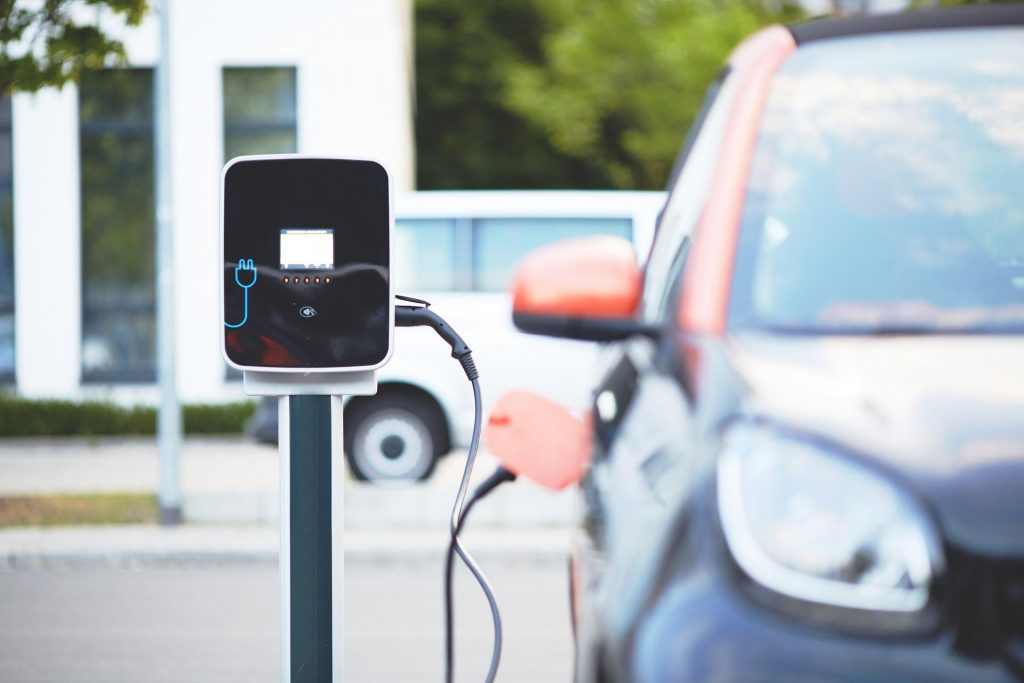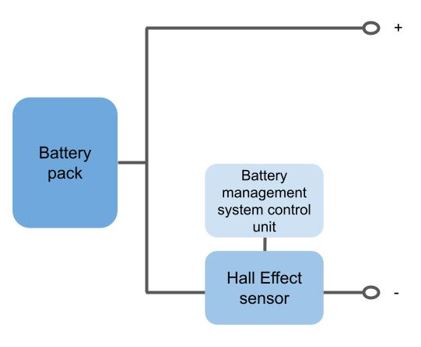Battery Management Sensors and Systems in Electric Vehicles
Yang Liu Comments 2 comments

In recent years, more and more electric vehicles (EVs) can be seen on the road, along with charging stations that can easily be found around the corner. The global EV market also proved the growing popularity of sustainable mobility, from a market value of $163 billion in 2020 to a projected value of $824 billion by 2030.
In order to meet the growing demand for EVs, and to ensure the proper functioning of batteries for high-power EV applications, battery management sensors and battery management systems are often installed in EVs, serving the vital purposes of maintaining batteries’ safety, reliability, and durability.
In this article, we will provide an overview of battery management sensors and battery management systems in EVs, as well as their functions and importance for their application in the growing trend of sustainable mobility. But first, let’s find out what has motivated drivers to adopt EVs as their mode of transportation?
What are the benefits of driving an EV?
Unlike internal combustion engines in conventional vehicles, EVs are powered by an electric motor, in which the electric energy is stored and discharged via a pack of rechargeable batteries. Through the usage of these batteries, EVs are important in promoting the usage of sustainable power sources, such as solar, wind or hydropower, and thereby reducing the heavy emissions from petroleum-powered mobility.
EVs also offer the flexibility of ‘repowering’ the vehicle. Instead of being subject to the fluctuating price of diesel and gasoline, EV users can enjoy the convenience of charging at home or many other charging stations with a predictable price. In addition, EVs offer a sense of comfortability, in which the weight and the distribution of the EV batteries allow for a low center of gravity, improving the overall handling and driving experience.
In order to meet the growing demand and further incentivize adoption of sustainable mobility, EV batteries are an essential driver in fostering the development and the market growth of these vehicles. With advancements in EV batteries’ development, higher power storage and thus longer distance traveling are now possible, while faster charging allows flexibility and convenience for the drivers.
Let’s take a look at the basics of batteries in EVs!
What are the principles behind batteries in EVs?
There are various types of batteries used as energy storage in EVs, with lithium-ion batteries (LIBs) being the most common type. Other types, such as lead-acid batteries and nickel metal hydride batteries, can also be found in some cars.
For an EV powered by LIBs, the battery pack consists of multiple battery modules, and inside the modules are many small and individual battery cells. Within the LIBs, components include cathode and anode materials, a separator, and electrolytes.
The batteries store energy as well as provide power to the vehicle motor in the form of electricity. The cells discharge when lithium-ions flow from the anode to the cathode, and lithium-ions flow in the opposite direction when the vehicle charges.
Why are battery management sensors and management systems necessary?
Despite current technology advancements and various environmental, economic and social benefits, EVs suffered from negative publicity on safety issues due to their battery-powered source.
EV batteries, like any other rechargeable batteries, are subject to a narrow operating temperature range and the risk of thermal runaway. This is due to the organic liquid electrolytes in batteries being volatile and flammable when exposed to high temperatures. Fire risks can also spread to adjacent cells, causing a chain reaction of more heat and toxic gas release. Thermal runaway can occur under various conditions, including physical damage and chemical leakage of the electrolytes during car accidents, over-voltage and high temperature due to fast charging of the vehicles, as well as short circuits due to faulty production to the batteries.
As a result, battery management sensors and management systems are often applied in EVs for temperature, voltage, and current measurement in harsh vehicle operating environments, as well as energy flow control necessary to maintain the proper functioning of the batteries. Thus, battery management sensors and management systems in EVs are important in enhancing the safety, reliability, and durability of the batteries and the performance of the vehicle.
And now let’s take a deeper look at the battery management sensors and systems!
What is a battery management system?
A battery management system consists of hardware and software for the control of battery charging and discharging within safety limits. These components include battery management sensors, actuators, and controllers which have various algorithms and signal wires.
What are battery management sensors?
Battery management sensors are responsible for measuring parameters in order to ensure battery operation within safety limits. The sensors can be found on the batteries or on the cells, and include:
- Temperature sensor: which measures the temperature of the battery pack;
- Voltage sensor: which measures voltage among the battery terminals;
- Current sensor: which measures current flow through the positive or negative battery terminal.

Hall Effect Current sensors are commonly used for current measurement in battery management systems. A primary conductor generates a magnetic field when current flows through it. This magnetic field is significantly concentrated in a toroidal core. In the core’s air gap a Hall element is placed, which generates a Hall voltage which is subsequently amplified and processed by a signal processing circuit to a signal containing information of the current flowing through the primary conductor.
Data of the measured signals are then collected and sent to the control unit for analysis and feedback, as seen in the circuit diagram in figure 3. The control unit is located in the battery pack or in the charger. And together they are classified as the battery management system, in order to serve the purposes of maintaining batteries’ safety, reliability, and durability.

What are the functions of a battery management system in EVs?
- Battery parameter detection: including the detection of the total current, total voltage, individual cell voltage, impedance, insulation, and so on.
- Battery states estimation: including the estimation of the state of charge and depth of discharge by sensing the working current, voltage, and temperature; the estimation of the state of health via the battery degradation analysis; as well as the estimation of the state of function with respect to the state of charge, state of health and the operating environment of the batteries.
- On-board diagnosis: including monitoring of sensor fault, battery fault, overvoltage (overcharge), Undervoltage (over-discharge), as well as overly high or fast increase in temperature.
- Battery safety control and warning: including diagnosing faults in the thermal control and voltage safety control, as well as initiating preventive measures when certain thresholds are exceeded.
- Charge control: which allows the battery management system in order to control the charging of batteries.
- Thermal management: which initiates heating or cooling for the batteries when needed.
- Information storage: which records key data such as the state of charge and the stage of health.
- Networking: This allows online monitoring as well as calibrating of the battery management system without having to disassemble the vehicle.
Examples of the battery management system applications include:
- When the battery management sensors detect a low charge in batteries, the system will disable the stop-start feature of the vehicle.
- Warning messages will notify and advise drivers to reduce power consumption, such as to switch off heated seats or the navigation.
- The management system will shut off the battery power supply when voltage safety thresholds are exceeded, in order to prevent injuries to vehicle occupants due to electric leakage.
Technological advancements and research on improving the safety, reliability, and efficiency of battery management systems for EVs have taken place in recent years. Nonetheless, certain limitations of these devices remain. Let’s take a further look at the challenges for state-of-the-art battery management systems!
What are the limitations and challenges of battery management systems?
- Precise measurements of battery parameters, such as cell voltage and state of health, are still inadequate.
- Optimal charging of batteries remains more time-consuming and less safe than gasoline refueling. Reduction of charging time would result in an increase in charging current that is above safety limits. This requires further research and optimization to enable safe and fast charging and to reduce the degradation of battery state of health.
- Reusing of battery management systems is limited, thus, it could result in a large amount of electronic waste generated as the demand for EVs increases.
- Non-universality of the battery fuel gauge, which is used to determine battery state of charge as well as state of health, limits its application to certain chemistry, manufacturer, and size of the battery. As a result, this increases the cost of application and reduces the possibility of reusing and repurposing. Therefore, adaptive strategies for universal and multi-usage battery management systems to minimize electronic waste are necessary.
- Malfunction of battery management sensors can be results of issues, such as, loosening of battery terminals, humidity, or corrosion around the devices, affecting the accuracy and effectiveness of the battery management system. Thus, it is important to monitor the tightness of the battery pole terminals, as well as the cleanliness and dryness of the battery sensors.
Conclusion
Applications of battery management sensors and management systems in EVs provide important temperature, voltage, and current measurements in harsh vehicle operating environments, as well as energy flow control. Therefore, they are necessary for ensuring the safety, reliability, and efficiency of EV batteries amongst the growing popularity and adoption of EVs. In order to support the sustainability concept of EVs, further research on multi-usage EV batteries and universal battery management systems is needed, as well as on the continuous optimization of battery charging and accuracy measurements.
ChenYang Technologies offers a wide range of different Hall Effect sensors for multiple applications. Based on the requirements, ChenYang Technologies provides customers with the best solution for their applications. Even custom-made products with special requirements can be provided by us.
Visit our company website https://www.chenyang-gmbh.com/en/ and http://www.chenyang.de for more information.
Learn more about application of Hall Effect sensors in the automotive industry.
Literature:
AG, I. T. (n.d.). Battery Management System (BMS). Infineon Technologies. Retrieved August 5, 2022, from https://www.infineon.com/cms/en/applications/solutions/battery-management-system/
Balasingam, B., Ahmed, M., & Pattipati, K. (2020). Battery Management Systems—challenges and some solutions. Energies, 13(11), 2825. https://doi.org/10.3390/en13112825
BatteryBitsEditors. (2021, February 27). Electric vehicles: The Perilous State of Battery Safety. Medium. Retrieved August 5, 2022, from https://medium.com/batterybits/electric-vehicles-the-perilous-state-of-battery-safety-4efa85bc6b4
CB Insights. (2021, September 15). The Race For The Electric Vehicle. CB Insights. Retrieved August 5, 2022, from http://www.cbinsights.com/research/report/electric-car-race/
Chaturvedi, N. A., Klein, R., Christensen, J., Ahmed, J., & Kojic, A. (2010). Algorithms for advanced battery-management systems. IEEE Control Systems, 30(3), 49–68. https://doi.org/10.1109/mcs.2010.936293
Dragonfly Energy. (2022, April 5). What is thermal runaway in batteries? Dragonfly Energy. Retrieved August 5, 2022, from https://dragonflyenergy.com/thermal-runaway/
Gibson, E. (2022, July 5). What is a battery management system sensor in a car? PoweringAutos. Retrieved August 5, 2022, from https://poweringautos.com/what-is-a-battery-management-system-sensor-in-a-car/
IEE Smart Sensing Solutions. (2021, December 9). Battery management. IEE Smart Sensing Solutions. Retrieved August 5, 2022, from https://iee-sensing.com/automotive/battery-management/
Jadhav, A., & Mutreja, S. (2022, January). Electric vehicle market share, growth, size, analysis 2022-2030. Allied Market Research. Retrieved August 5, 2022, from https://www.alliedmarketresearch.com/electric-vehicle-market
Johnson, E.(2019, July 31). Introduction to electric vehicle battery systems – technical articles. All About Circuits. Retrieved August 5, 2022, from https://www.allaboutcircuits.com/technical-articles/introduction-to-electric-vehicle-battery-systems/
Kapoor, R. (2021, October 7). This is why electric vehicles can catch fire. HotCars. Retrieved August 5, 2022, from https://www.hotcars.com/this-is-why-electric-vehicles-can-catch-fire/
Lampton, C. (2008, August 18). How electric car batteries work. HowStuffWorks. Retrieved August 5, 2022, from https://auto.howstuffworks.com/fuel-efficiency/vehicles/electric-car-battery.htm
Learning about Electronics. (2018). How to Sense Current in a Battery Management System. Learning about Electronics. Retrieved August 5, 2022, from http://www.learningaboutelectronics.com/Articles/How-to-sense-current-in-a-battery-management-system.php
Lithion Recycling. (2022, June 17). What types of lithium-ion batteries can be found in EVS? Lithion Recycling. Retrieved August 5, 2022, from https://www.lithionrecycling.com/what-types-of-lithium-ion-batteries-can-be-found-in-evs/
Lu, L., Han, X., Li, J., Hua, J., & Ouyang, M. (2013). A review on the key issues for lithium-ion battery management in Electric Vehicles. Journal of Power Sources, 226, 272–288. https://doi.org/10.1016/j.jpowsour.2012.10.060
OVO Energy. (2022). Benefits and advantages of electric cars. Retrieved August 5, 2022, from https://www.ovoenergy.com/electric-cars/benefits.
Patil, S.(2019, March 5). Current sensing solutions in EV/HEV batteries. Circuit Digest. Retrieved August 5, 2022, from https://circuitdigest.com/article/current-sensing-solutions-in-ev-hev-batteries
Person, & Yang, H. (2021, August 23). Explainer: Are lithium-ion batteries in Evs a fire hazard? Reuters. Retrieved August 5, 2022, from https://www.reuters.com/business/autos-transportation/are-lithium-ion-batteries-evs-fire-hazard-2021-08-23/
Vlad Samarin, S. (2021, August 01). Battery sensor: How it works, problems, checking, battery replacement. icon. Retrieved August 5, 2022, from https://www.samarins.com/glossary/battery-sensor.html
2 thoughts on “Battery Management Sensors and Systems in Electric Vehicles”